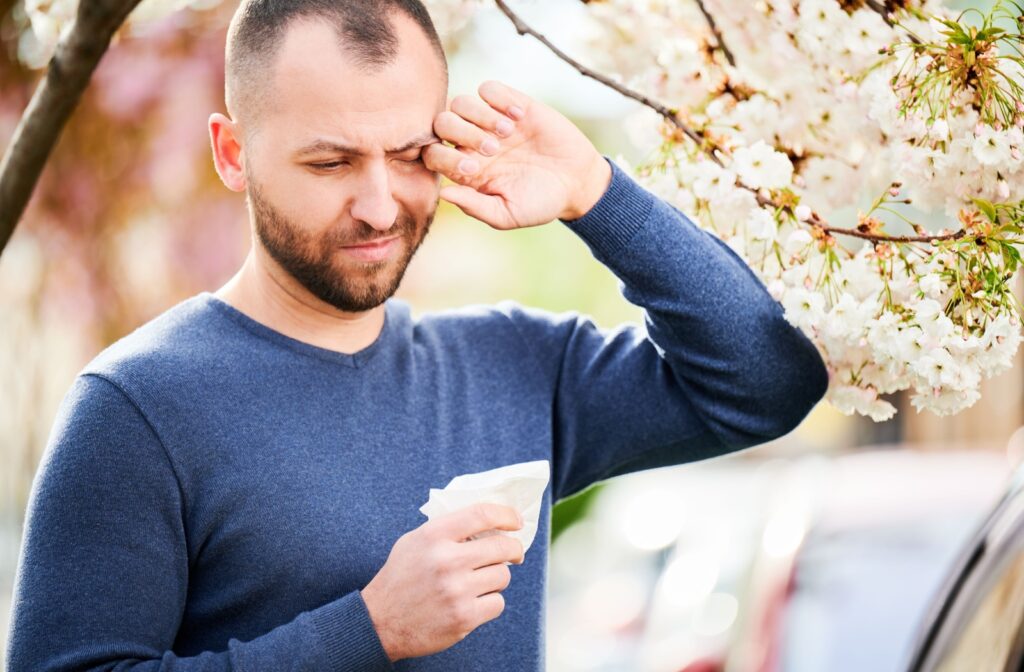While dry eyes are often chalked up to screen time or dry weather, they may actually be related to another frustrating condition. For many people, dry eyes are a common symptom of allergies linked to triggers like pollen, dust, or pet dander.
However, not all cases of dry eye are allergy-related, and causes can vary widely. Your optometrist can help you determine what’s causing your discomfort and, better yet, put you on the path to relief!
What Are Eye Allergies?
Allergies are essentially your immune system’s hypersensitive reaction to otherwise harmless substances. With eye allergies, also known as allergic conjunctivitis, this inflammation occurs in the white part of your eye, the conjunctiva. Common triggers include environmental allergens like pollen, dust mites, mold, and pet dander.
These culprits cause an immune response, leading to symptoms like:
- Irritation
- Itchy eyes
- Redness
- Burning
- Clear discharge
And, of course, dry eyes. Dry eyes can result when the inflammation caused by allergies disrupts your tear gland function. This can reduce tear production and quality, leaving your eyes feeling dry and irritated.
What Exactly is Dry Eye?
There are 2 primary types of dry eye:
- Aqueous Deficient Dry Eye: When your tear glands fail to produce enough tears.
- Evaporative Dry Eye: When your tears evaporate too quickly due to poor tear quality.
Unlike allergies, dry eye isn’t always influenced by your environment. Its triggers can also include:
- Medical conditions
- Medications
- Hormonal changes
- Prolonged screen time.
Symptoms like light sensitivity, blurry vision, and the uncomfortable sensation of something in your eye can overlap with those of eye allergies, which can complicate diagnosis. It’s worth noting that allergies may also exacerbate already present dry eye symptoms by heightening inflammation and further disrupting your tear film.
Diagnosing Eye Discomfort
If your dry eyes are bothering you, we can help determine what’s going on. With an eye exam, we can examine your tear film and ask about your medical history to see if allergies or something else might be causing the issue.
Once we know the cause, we can recommend solutions tailored just for you.
Lifestyle Changes to Manage Dry Eye
Sometimes, simple routine tweaks can alleviate symptoms. Consider:
- Using a humidifier: Add moisture to the air in your home or workspace.
- Wearing wraparound glasses: Protect your eyes from contact with allergens.
- Taking screen-time breaks: Give your eyes time to reset and rest.

At-Home Dry Eye Therapies
Artificial tears and allergy-specific eye drops can provide temporary relief. Look for preservative-free formulas to minimize further irritation. For persistent dryness, prescription eye drops are a common and highly effective treatment. Some drops help by reducing inflammation, boosting tear production, or improving your eye’s natural hydration.
If you need longer-lasting relief, gels and ointments can be a great option, especially at night. These thicker products act like a shield for your eyes, locking in moisture and keeping them hydrated while you sleep.
If allergies are triggering your dry eyes, antihistamine drops can help reduce inflammation and irritation.
Clinical Dry Eye Treatments
For persistent cases, we can offer specialized treatments, such as:
IPL Treatment
Intense Pulsed Light (IPL) therapy is a non-invasive way to tackle dry eye caused by meibomian gland dysfunction. These tiny glands along your eyelids are responsible for producing the oil that keeps your tears from evaporating too quickly.
In IPL, light pulses are delivered to the skin around your eyes, melting blockages and soothing inflammation. The treatment is quick, easy, and usually well-tolerated, with little to no downtime. After a few sessions, many people notice their eyes feel less irritated, their tears are more stable, and redness or discomfort is reduced.
RF (Radiofrequency) Therapy
RF treatment uses gentle heat generated by radiofrequency energy to warm the eyelids and stimulate the meibomian glands. This can help improve oil flow and reduce inflammation, making your tears more stable and reducing dry eye symptoms. RF also provides the added benefit of tightening skin, which some patients appreciate as a cosmetic bonus. Treatments are comfortable, quick, and require little to no downtime.
LipiFlow
LipiFlow can be a game-changer for anyone struggling with dry eyes. This treatment uses a mix of heat and gentle massage to clear out those blockages and get your glands working again.
During the procedure, we will place a comfortable device over your eyelids, warming the inner lid and applying light pressure to help clear the glands. The process is quick—about 12 minutes—and most people find it quite comfortable.
Tips to Keep Allergies in Check
Managing allergies effectively may reduce the likelihood of experiencing dry eyes to begin with. Here are some tips to help you stay ahead:
- Learn and eliminate your triggers as much as possible.
- Maintain clean, allergen-free indoor air.
- Strengthen your immune system by following a nutritious diet.
- Rely on allergy medications when necessary.
- Avoid touching your eyes to minimize exposure to allergens.
Consistency with these strategies can help maintain healthier eyes through allergy season and beyond.
See Clearly & Comfortably Again
Your eyes deserve professional care and attention, especially when dealing with the frustrating combination of allergies and dry eyes.
If discomfort is holding you back or affecting your day-to-day routine, we’re here to help! At Dr. Zargar Eyecare, we use precise diagnostic technology and a warm, welcoming approach to help you get the relief you deserve. Visit us to explore tailored treatments that fit your lifestyle.Book your appointment today and rediscover what clear, comfortable vision feels like!

